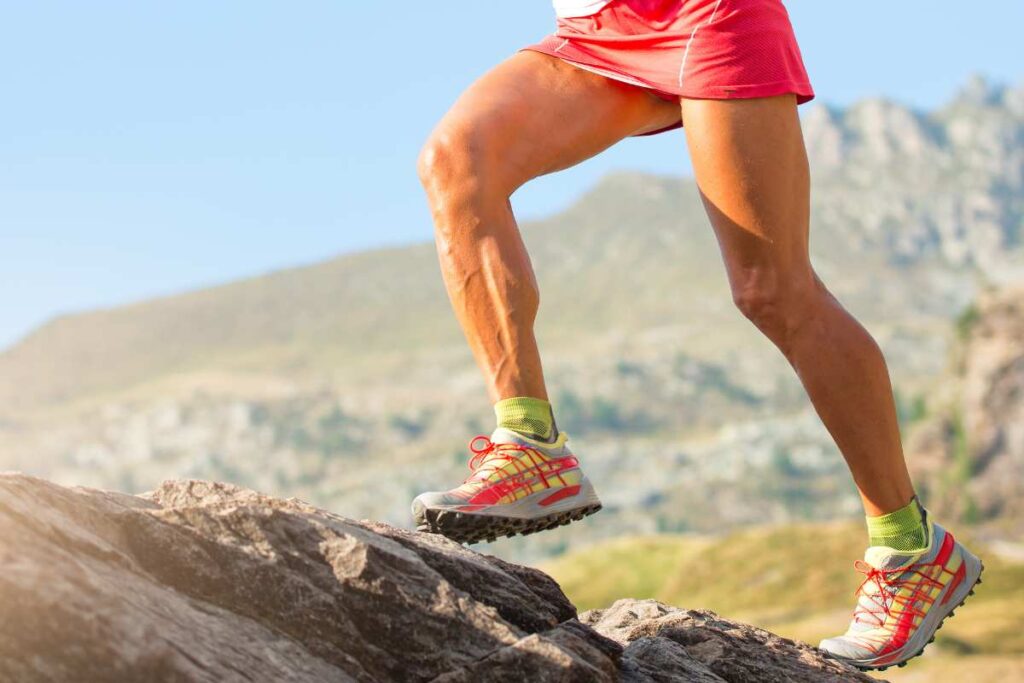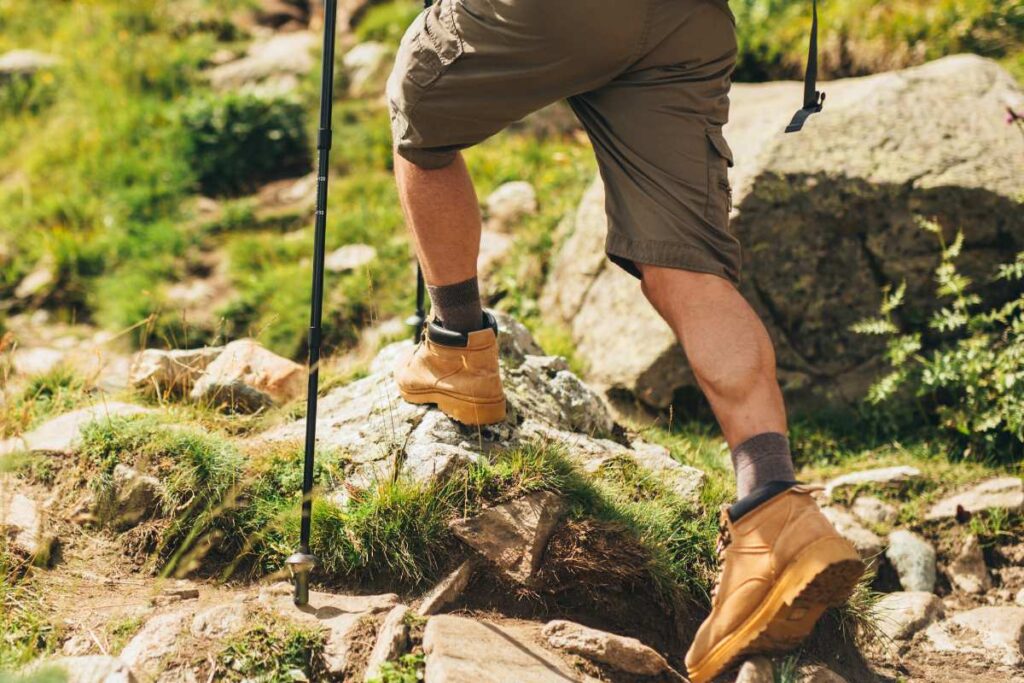Hiking is not typically the first activity that comes to mind when thinking about building muscle, but it is indeed an effective way to strengthen your body.
As an exercise that combines the benefits of cardiovascular training with resistance work, hiking challenges multiple muscle groups in your body.
The varied terrain of hiking trails means you’re constantly adjusting your balance and using different muscles to stabilize yourself, particularly in your lower body.
Does Hiking Build Muscle?

When you hike, particularly on routes that include elevation gains, you engage the large muscle groups in your legs such as the quadriceps, hamstrings, and glutes.
In addition to these primary movers, stabilizing muscles in your core and lower back also get a workout as they maintain your balance and posture.
The result is a full-body workout that can enhance your muscular strength and endurance, contributing to your overall fitness.
Carrying a backpack adds an additional level of resistance to your hike, increasing the challenge for your muscles.
Your shoulders, back, and core bear the load of the backpack, which can help to build muscle strength in these areas.

Whether you hike for the sheer pleasure of being in nature or with fitness goals in mind, the activity is a valuable addition to a well-rounded exercise regime that promotes strength and overall health.
Hiking as a Full-Body Workout

When you hike, your body engages in an activity that works various muscle groups simultaneously, making it an efficient full-body workout.
Engaging Multiple Muscle Groups
During a hike, your leg muscles, including the quadriceps, hamstrings, and calves, are continuously activated with each step you take.
This repetitive motion stimulates the muscle fibers, promoting strength as you navigate the varied terrain. The core muscles, which encompass your abs and lower back, act as stabilizers, sustaining your balance and alignment on unsteady surfaces.
Hiking Goes Beyond Just Leg Work
While it’s well-known that hiking strengthens the legs, it also involves the upper body to a significant extent. As you climb or use trekking poles, you work out your shoulders, arms, and chest.
Moreover, the core muscles play a crucial role beyond balance—they contribute to power generation and the distribution of energy throughout the body as you move.
The Science of Muscle Building

In your quest to build muscle, it’s crucial to understand how your body responds to different forms of exercise.
Hiking provides a unique combination of resistance and varied terrain that can trigger muscle growth.
Understanding Hypertrophy
When you engage in activities such as hiking, your muscles undergo hypertrophy, which is the increase in muscle size.
This process occurs when muscle fibers are damaged through exertion against resistance, prompting them to repair and grow thicker during recovery.
For hypertrophy to happen, you need two essential elements:
- Progressive Overload: Over time, you must increase the intensity of your activity.
- Adequate Recovery: Your muscles need time to repair, which is when the actual muscle building happens.
Engaging in regular hiking exploits both these elements. As you hike, especially with added weight like a backpack, you continually challenge your muscles against gravity, promoting muscle hypertrophy.
The Role of Resistance and Terrain
The environment in which you hike plays a vital role in the muscle-building process:
- Resistance: This comes from gravity, the incline of the trail, and any additional weight you carry. Your muscles must work harder to overcome these resistive forces, leading to increased muscle strength and mass.
- Terrain: Uneven and varied terrain requires more from your stabilizer muscles, which are often neglected in a standard gym environment. Such terrain can lead to improved muscle gains as your body adapts to the stresses placed upon it.
When hiking, the resistance primarily impacts your legs and glutes, with your quads, hamstrings, and calf muscles being the primary movers.
Your core muscles also engage to maintain balance, contributing to an indirect, yet effective, core workout.
By frequently tackling challenging trails, you can make substantial strides in muscle strength and even muscle mass over time.
Cardiovascular and Muscle Endurance

When you hike, you engage in a cardiovascular workout that not only burns calories but also enhances your muscle endurance.
This activity becomes especially effective when you encounter trails with varying elevation and incline.
Benefits of Cardio Training on Trails
The act of hiking itself is a cardiovascular activity that works your heart and lungs.
When you hit the trails, you’re typically facing a range of terrains that challenge your body differently at every turn.
A trail’s undulating surfaces, mixed with natural obstacles, compel your heart to work harder and, in turn, strengthen it.
- Calorie Burn: Hiking can significantly burn calories based on the intensity of the hike and your body weight.
- Cardiovascular Fitness: Engaging in regular hiking can lead to improvements in your overall cardiovascular fitness.
Improving Stamina with Elevation and Incline
Hiking trails with elevation gain and incline push your body to adapt to laborious conditions, improving your stamina.
- Energy Output: As you tackle inclines, your body requires more energy, enhancing your endurance as your muscles work to propel you upward.
- Stamina Development: Persisting through challenging elevation can lead to increased stamina, as your body learns to sustain energy output over more extended periods.
By regularly hiking on varied terrain, you can develop a strong cardiovascular system along with improved muscle endurance.
Nutrition and Recovery
Proper nutrition and recovery play pivotal roles in muscle building from hiking. They ensure that your body repairs muscle tissue and gets stronger.

Optimizing Nutrition for Muscle Repair
To promote muscle repair after hiking, focus on protein intake.
You should aim to consume a balance of essential amino acids, which are the building blocks of protein necessary for muscle repair and growth.
Protein sources include:
- Lean meats: chicken, turkey, and fish
- Dairy: milk, cheese, and yogurt
- Plant-based: beans, lentils, and tofu
Additionally, your body needs sufficient calories, including carbohydrates and fats, to fuel the repair process.
Consider incorporating complex carbohydrates like whole grains, which provide sustained energy, and healthy fats such as avocados and nuts to support cellular repair.
Importance of Rest and Sleep
Rest is just as important as physical activity. Taking regular rest days allows your muscles to repair and strengthen.
During rest days, you still need nutrient-rich foods to support the recovery process.
Proper sleep is essential for muscle recovery. Aim for 7-9 hours of quality sleep per night. Sleep boosts growth hormone levels, facilitating muscle repair.
To enhance sleep quality:
- Maintain a regular sleep schedule.
- Create a comfortable, dark, and cool sleep environment.
- Avoid stimulants like caffeine close to bedtime.
By emphasizing proper nutrition and recovery through rest and sleep, you equip your body with the tools it needs to build muscle effectively after hiking.
Incorporating Additional Exercises
To further the muscle-building benefits of hiking, consider incorporating additional exercises that target strength and balance.
Complementing Hiking with Strength Training

In the Gym: To augment your hiking regimen, engage in strength training at the gym.
A structured workout should emphasize the lower body, core, and upper body strength, vital for challenging hikes.
- Lower Body: Execute exercises like squats and lunges to target your quadriceps, hamstrings, and glutes – muscles heavily relied upon when hiking.
- Core: Strengthen your core with planks and Russian twists, as a strong core improves your hiking endurance and stability.
- Upper Body: Include upper body workouts such as push-ups and dumbbell rows to aid in navigating uneven terrains and using trekking poles effectively.
At Home: If you prefer home workouts, bodyweight exercises can be similarly effective. Create a balanced routine that still focuses on the key muscle groups used in hiking.
Balancing Workout Routines
Training Schedule: Balance your physical activities throughout the week to give your body adequate time to recover.
For instance:
- Monday: Strength training (gym or home)
- Wednesday: Cardio-focused training
- Friday: Full-body workout session
- Weekend: Reserved for hikes to practice and apply your improved physical strength and endurance.
Exercise Variety: Incorporating different forms of exercise, like swimming or cycling, can complement your hiking by improving overall fitness and ensuring a full-body workout. This variety also prevents overuse injuries and maintains a high level of motivation.
Remember, consistent physical activity combined with targeted training exercises fortifies your hiking ability and contributes to building and maintaining muscle mass. Keep your workouts varied and aligned with your hiking goals for optimal results.
Increasing Hiking Intensity

To build muscle effectively through hiking, you must increase intensity.
This can be achieved by adding weight which acts as resistance, thereby challenging your muscles further.
Using Weighted Vests and Ankle Weights
Weighted Vests: You can significantly increase the intensity of your hikes by wearing a weighted vest. This additional weight adds resistance, making your leg and core muscles work harder with each step. Start with a lighter vest and gradually increase the weight to prevent injury.
- How to Use:
- Begin with 5-10% of your body weight in the vest.
- Gradually add weight over time, not exceeding 10-15% of your body weight.
Ankle Weights: Adding ankle weights boosts the effort your lower body exerts, which can lead to strength gains, particularly in the calves, quadriceps, and hamstrings.
- Cautions:
- Use with care, as these can alter your walking pattern and potentially cause strain.
- Keep ankle weights light, generally no more than 1-3 pounds on each ankle.
Incorporating Trekking Poles

Trekking Poles: Trekking poles not only improve balance but also increase upper body engagement. The use of poles introduces resistance that can enhance your muscular endurance and strength.
Benefits:
- Aids in distributing the workout across your arms, shoulders, and back.
- Can help manage weight distribution and reduce impact on knees during descents.
Techniques for Increased Intensity:
- Use a firm grip and engage your arms actively as you walk.
- Plant the poles firmly and push off to propel yourself forward, thereby working your triceps and shoulders.
Find out 🚶 How to Strengthen Knees for Hiking?
Listening to Your Body
When engaging in physical activities like hiking, it’s vital to heed your body’s feedback to optimize muscle building while avoiding negative health implications.
Recognizing Signs of Overtraining
Soreness vs. Pain: After hiking, it’s normal to experience muscle soreness, which typically peaks 24-48 hours post-activity.
This is a sign that your muscles are adapting and is often referred to as Delayed Onset Muscle Soreness (DOMS).
- Muscle Soreness: Common and can feel like a dull, aching sensation in the affected muscles.
- Pain: Sharp, persistent pain may indicate an injury.
Other Overtraining Symptoms:
- Chronic fatigue
- Difficulty sleeping
- Elevated resting heart rate
- Decreased performance and endurance
- Loss of appetite
- Irritability or mood swings
Adapting Workouts to Avoid Injury
Start Gradually: Increase the difficulty of your hikes over time to allow your body to adapt safely and reduce the risk of injury.
- Balance and Posture: Focus on exercises that enhance core strength off the trail to maintain stability and posture while hiking.
- Physical Activity Variation: Complement hiking with low-impact activities like swimming or cycling for overall muscle recovery and cardiovascular health.
Rest and Recovery:Ensure adequate recovery time between hikes to allow for muscle repair and to avoid the negative effects overtraining can have on mental health, including the risk of depression.
- Recovery Techniques:
- Proper hydration and nutrition
- Adequate sleep
- Gentle stretching or yoga
Monitoring Health Indicators: Regular physical activity like hiking can improve bone density, balance, and reduce the risk of chronic conditions such as heart disease. Pay attention to how your body feels during and after hikes to gauge if you’re positively impacting your health or if you need to adjust your routine.
Fitness Tracking and Progress Monitoring
Tracking your fitness progress is crucial when hiking to enhance muscle strength, fitness level, and overall muscle tone.
By monitoring progress, you can align your hiking activities with your fitness goals, whether it’s for strength, weight loss, or muscle tone improvement.
- Rugged GPS watch built to withstand the toughest environments.Supported Application:Phone. . Wireless comm standard:Bluetooth
- Constructed to U.S. Military standard 810G for thermal, shock and water resistance (rated to 100 meters)
- Built in 3 axis compass and barometric altimeter, plus multiple global navigation satellite systems (GPS, Glonass and Galileo) support helps track in more challenging environments than GPS alone
- Monitor your estimated heart rate, activity and stress; Train with preloaded activity profiles. Strap material: Silicone
- Stay connected with smart notifications (with a compatible smartphone) and automatic data uploads to the Garmin connect online fitness community
Setting Achievable Goals
To optimize hiking for muscle building, set clear and specific goals.
Begin by establishing what you want to achieve, like:
- Increase in muscle strength: Target how much more you want to be able to carry or the steepness of the hikes you wish to conquer.
- Enhanced muscle tone: Decide on the muscle groups you want to focus on and tailor your hikes accordingly.
- Weight loss: Set a target weight or body fat percentage to work towards.
| Goals | Description |
|---|---|
| Muscle Strength | Setting the amount of weight you can carry or bench press as a goal. |
| Muscle Tone | Defining which muscle groups you want to see more defined. |
| Fitness Level | Aiming for longer hikes or those with more challenging terrains. |
| Weight Loss | Targeting a specific weight or body mass index (BMI). |
Measuring Improvement Over Time
To gauge your improvement, use fitness trackers or GPS watches that provide data to help you:
- Track the duration and steepness of your hikes.
- Monitor heart rate to understand cardiovascular improvements.
- Measure the distance covered to see improvements in stamina.
To maximize muscle tone and strength, consistently review and adjust your training schedule based on data:
- Week Over Week Analysis: Look for improvements in pace or distance.
- Consistency: Ensure regular hiking to promote progressive muscle overload.
Remember, regular tracking of these metrics will make it easier for you to adjust your training for optimal results.
Use the technology at your disposal to measure your improvement and push your limits, resulting in better fitness levels and stronger muscles.







